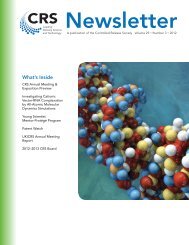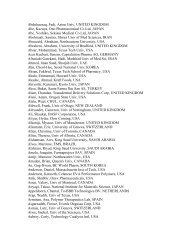CRS Newsletter. Volume 23, Number 3. 2006 - Controlled Release ...
CRS Newsletter. Volume 23, Number 3. 2006 - Controlled Release ...
CRS Newsletter. Volume 23, Number 3. 2006 - Controlled Release ...
You also want an ePaper? Increase the reach of your titles
YUMPU automatically turns print PDFs into web optimized ePapers that Google loves.
Cationic Liposomes Are Promising<br />
in Drug and Gene Delivery<br />
NewsRx.com: Apr. 12, <strong>2006</strong> – According<br />
to recently published research from Japan,<br />
cationic liposomes are promising in drug<br />
and gene delivery. “After intravenous<br />
administration of plasmid DNA (pDNA)/<br />
cationic liposome complexes, the gene<br />
expression is predominantly observed in<br />
the lung due to the physicochemical<br />
properties of the liposome complexes and<br />
the physiology of the lung,” write W.<br />
Yeeprae and colleagues from Kyoto<br />
University.<br />
“To determine the physicochemical<br />
properties and distribution behavior of<br />
cationic liposomes for lung-selective drug<br />
and/or gene delivery systems, N-[1-(2,3dioleyloxy)propyl]-n,n,n-trimethylammonium<br />
chloride (DOTMA)/cholesterol and<br />
1,2-dioleoyl-3-trimethylammoniopropane<br />
(DOTAP)/cholesterol liposomes were<br />
studied,” they explain. “The particle sizes<br />
of DOTMA/cholesterol and DOTAP/<br />
cholesterol liposomes were very similar:<br />
126 and 128 nm, respectively.<br />
Furthermore, the zeta potentials of these<br />
two liposomes were 51 and 66 mV,<br />
respectively. After intravenous injection<br />
into mice, both cationic liposomes were<br />
rapidly eliminated from the blood<br />
circulation and preferentially recovered in<br />
the lung. Interestingly, the highest lung<br />
accumulation was observed at 1 min, and<br />
then, decreased gradually,” the researchers<br />
report.<br />
Yeeprae and colleagues published their<br />
study in Pharmazie (Physicochemical and<br />
pharmacokinetic characteristics of cationic<br />
liposomes. Pharmazie, <strong>2006</strong>;61(2):102-<br />
105).<br />
Targeted Drug Delivery Now<br />
Possible with “pHLIP” Peptide<br />
M2 PressWIRE via NewsEdge Corp.,<br />
NEW HAVEN, Conn.: Apr. 12, <strong>2006</strong> –<br />
Scientists at Yale and the University of<br />
Rhode Island have reported the<br />
development of a peptide that can<br />
specifically and directly deliver molecules<br />
to the inside of cells like a nano-syringe,<br />
creating a new tool for drug delivery, gene<br />
control, and imaging of diseased tissues.<br />
Their “cargo carrier” peptide called<br />
pHLIP, for pH (low) insertion peptide,<br />
accumulates in the membranes of cells in<br />
acidic environments and spontaneously<br />
transfers attached molecules across the<br />
membrane. The cargo is then released by<br />
cleavage of a sulfur-sulfur bond that is<br />
only unstable if it is inside the cell. The<br />
study, published early online in the<br />
Proceedings of the National Academy of<br />
Sciences, was led by Donald M. Engelman,<br />
professor of molecular biophysics and<br />
biochemistry at Yale.<br />
Itraconazole Has Been Formulated<br />
with Improved Dissolution and Oral<br />
Absorption<br />
NewsRx.com: Apr. 7, <strong>2006</strong> – Scientists in<br />
South Korea have conducted a study “to<br />
enhance the dissolution and oral<br />
absorption of poorly water-soluble<br />
itraconazole. A self-emulsifying drug<br />
delivery system (SEDDS) composed<br />
of oil, surfactant and cosurfactant for<br />
oral administration of itraconazole was<br />
formulated, and its physicochemical<br />
properties and pharmacokinetic<br />
parameters of itraconazole were evaluated.<br />
Among the surfactants and oils studied,<br />
Transcutol, Pluronic L64 and tocopherol<br />
acetate…showed the maximal solubility to<br />
itraconazole.”<br />
Hong and colleagues published their study<br />
in the Journal of <strong>Controlled</strong> <strong>Release</strong> (A new<br />
self-emulsifying formulation of<br />
itraconazole with improved dissolution<br />
and oral absorption. J Control <strong>Release</strong>,<br />
<strong>2006</strong>;110(2):332-338).<br />
A Mucoadhesive Hydrogel May<br />
Serve as a Drug Delivery Device to<br />
the Mucosal Epithelium<br />
NewsRx.com: Apr. 7, <strong>2006</strong> – A<br />
mucoadhesive hydrogel may serve as a drug<br />
delivery device to the mucosal epithelium.<br />
A self-folding miniature device has been<br />
developed to provide enhanced<br />
mucoadhesion, drug protection, and<br />
targeted unidirectional delivery. The main<br />
part of the device is a finger-like bilayered<br />
structure composed of two bonded layers<br />
H. Y. He and colleagues from Ohio State<br />
University write, “One is a pH-sensitive<br />
hydrogel based on crosslinked<br />
poly(methylacrylic acid) (PMAA) that<br />
swells significantly when in contact with<br />
body fluids, while the other is a non-<br />
swelling layer based on poly(hydroxyethyl<br />
methacrylate) (PHEMA). A mucoadhesive<br />
drug layer is attached on the bilayer. Thus,<br />
the self-folding device first attaches to the<br />
mucus and then curls into the mucus due<br />
to the different swelling of the bilayered<br />
structure, leading to enhanced<br />
mucoadhesion. The non-swelling<br />
PHEMA layer can also serve as a diffusion<br />
barrier, minimizing any drug leakage in the<br />
intestine. The resulting unidirectional<br />
release provides improved drug transport<br />
through the mucosal epithelium.” The<br />
researchers conclude, “The functionality of<br />
this device is successfully demonstrated in<br />
vitro using a porcine small intestine.”<br />
He and colleagues published their study in<br />
the Journal of <strong>Controlled</strong> <strong>Release</strong> (An oral<br />
delivery device based on self-folding<br />
hydrogels. J Control <strong>Release</strong>,<br />
<strong>2006</strong>;110(2):339-346).<br />
Shire’s DAYTRANA Transdermal<br />
Patch Approved<br />
PHILADELPHIA, Penn. and<br />
BASINGSTOKE, England, PRNewswire:<br />
Apr. 7, <strong>2006</strong> – Shire plc (LSE: SHP,<br />
NASDAQ: SHPGY, TSX: SHQ) has<br />
announced that the U.S. Food and Drug<br />
Administration (FDA) approved<br />
DAYTRANA (methylphenidate<br />
transdermal system), the first and only<br />
non-oral medication for the treatment of<br />
attention deficit hyperactivity disorder<br />
(ADHD). DAYTRANA, a once daily<br />
transdermal patch formulation of<br />
methylphenidate, will be available in 10,<br />
15, 20, and 30 mg dosage strengths.<br />
Shire and Noven Pharmaceuticals, Inc.<br />
submitted an amended New Drug<br />
Application (NDA) for DAYTRANA<br />
to the FDA in June of last year.<br />
DAYTRANA is licensed globally to<br />
Shire by Noven and will be available in<br />
pharmacies in the United States in <strong>2006</strong>.<br />
As part of the agreement between Shire<br />
and Noven for DAYTRANA, Shire<br />
completed an up front payment to Noven<br />
of $25 million in 2003 and may make<br />
separate milestone payments up to $125<br />
million: $50 million will be paid based on<br />
FDA approval, and $75 million will be<br />
paid based on the achievement of certain<br />
sales targets.<br />
In the News continued on page 40










